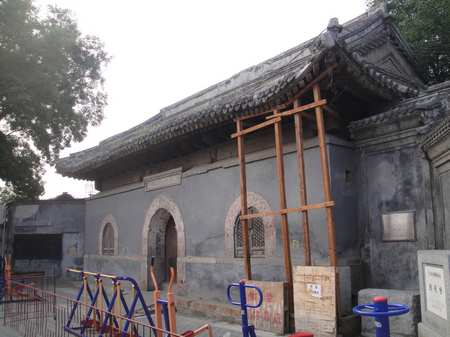Dashiqiao Hutong: at a dead end
|
|
|
Dashiqiao Hutong comes to an end by Nianhua temple. Photos: Yin Yeping |
Many of the hutong around the old Guloudajie in Xicheng district enjoyed a rich history as local temple sites. Among them was Dashiqiao Hutong, though today you could walk almost the whole length without noticing anything significant until you reach the very end. The end in itself is significant, as few hutong finish in a dead-end like this one, which stops abruptly next to the Nianhua Temple.
Established in 1581 by a monk from Sichuan province, the temple was originally called Huguobaoenqian Si, roughly meaning "Thousand-Buddha temple of national protection and gratitude repayment." The temple area covered around 180 houses and around 6,000 square meters. Inside was a stele that was presented with the handwriting of the emperor Yong Zheng. In 1734, the temple was restored and renamed Nianhua. In its heyday, the temple was full of treasures like copper statues of the 18 Buddhist arhats, and Buddha statues surrounded by thousands of metal lotus flowers. Yet after the monks and treasures were sent away during the Cultural Revolution (1966 - 76), Nianhua stepped down from its historical stage.
Now the front gate of the temple has to be supported with scaffolding to keep it from crumbling to pieces. Beside it, signs say, "Danger! Keep off." But you can still get in through another entrance next door. At the moment, the entire temple is occupied by the printing factory of Renmin University. Ironically, although the note says the temple has been under the protection of the Beijing Cultural Relic Bureau since 2005, it's still being used as a rental property.
In December 2009, a fire resulted in the severe damage of the old houses in No. 61, and even though this temple was on the Relic Bureau's 2005 list of cultural relics in danger, no practical preservation measures have been implemented.
Eighty-two-year-old Sun, who has lived at Dashiqiao Hutong for more than 20 years, said that the temple used to be a beautiful place crowded with houses and courtyards. "Now, as you can see, its insides are messily stuffed with newly built red-brick houses," she said. "There are only a few original buildings left there today." As a Buddhist, Sun used to go to the Guanghua Temple in Xicheng district very often, so she knew that the monks in Guanghua Temple were partially dispatched from here during the Cultural Revolution.
"Although No. 61 was a temple, it was used mainly for holding chambers [for the deceased]," said the 80-year-old Zhao. Because this area was close to the city wall in the north, Zhao said, rich people often gave money to the monks who put dead relatives inside the temple before transferring them out of the city for burial. "The temple was not for praying," Zhao said.
 0
0 








Go to Forum >>0 Comments